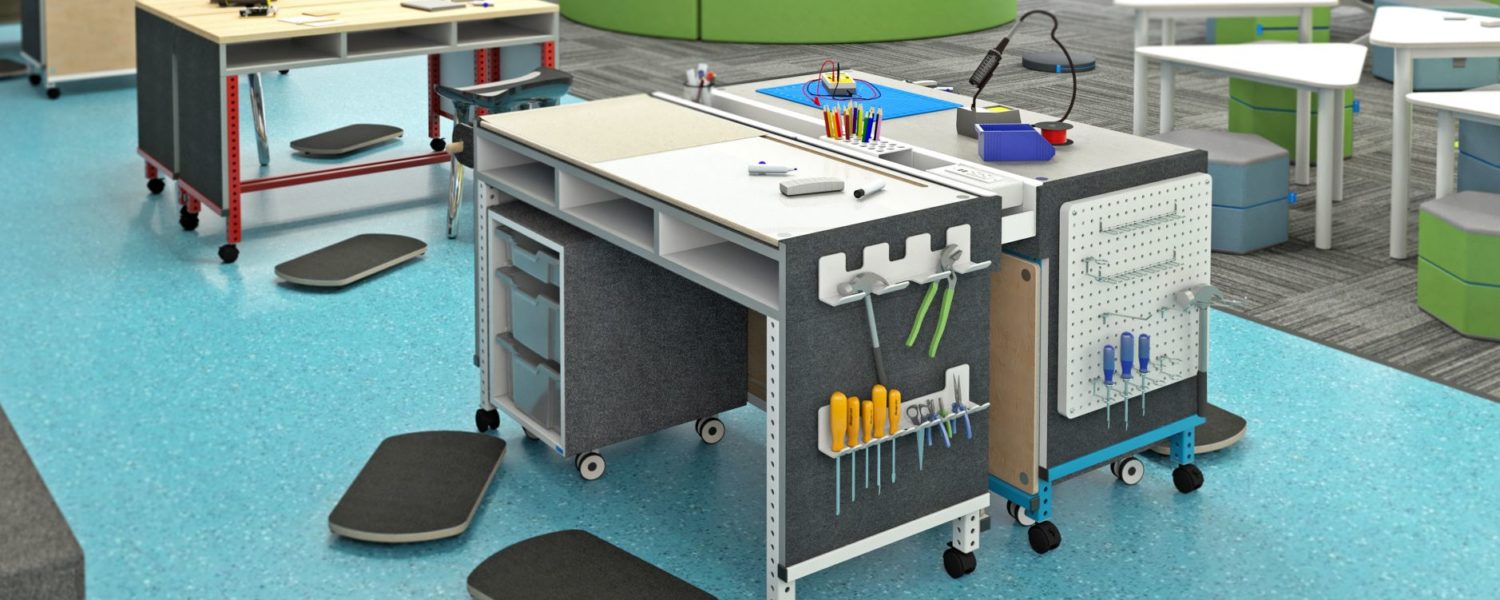By Katelyn Forcucci
Over the past several weeks, we have watched children adapt to learning at home. Whether this involves making a standing desk out of the kitchen counter or sitting on the floor and using the couch or coffee table as a workstation, learners are making this work.
What does this show us? Learners can, and need to, be trusted to drive their discovery of knowledge. While parents have observed this newfound autonomy, their children are able to navigate, schools can feel confident in beginning to implement contemporary and future-focused learning spaces in lieu of traditional classrooms.
The best place to start is with a STEAMspace. STEAM (Science, Technology, Engineering, Arts, Mathematics) is a cross-curricular way in which this is achieved in the learning environment.
Here are some things to consider when creating a STEAMspace learning environment in your school!
PURPOSE
Just as offices can get turned into storage spaces if planning changes, STEAMspaces can become the “overflow” room in a school. It is important to have a clear vision and mission for the STEAMspace.
What does the curriculum look like? What sort of projects and discovery will be fostered here? What supplies are needed? What type of storage will be necessary to ensure that this space doesn’t become overtaken with supplies? At the end of the term/semester/ year, what do I want my learners to take-away?
Regardless of the discussion you have with learners, administrators, and colleagues, one thing should be very clear: This space needs to be a conduit for learner engagement by fostering a learning-by-doing mentality. Learners should be trusted and empowered to drive their own knowledge discovery in a STEAMspace.
LAYOUT
Since learners are driving their learning in a STEAMspace, it is important to consider the layout of the environment. In this learning environment, teams may collaborate together, or scholars may critically think independently.
It’s important to provide agility in the space. Tables should be able to come together for discussion/problem-solving or be pulled apart for singular tasks. Does there need to be furniture that remains stationary in the room? Does the storage also serve as something else?
This is not a space that needs to be packed with furniture. Rather than 25 chairs for every learner, shift to a space for every learner. We see that schools regularly integrate work force/collegiate readiness into their school’s mission/vision statements. If this is indeed the case, the space needs to allow for autonomy and agency.
Most offices are open-concept, and some have gone away entirely with private offices. So, assigned “seats” don’t belong in a STEAMspace.
The space should focus on the “NOTDOT” (No One Thing Does One Thing) philosophy. This will ensure that learners have the space they need to complete the task on which they are working.
An agile space allows learners to be further empowered. Whilst creating, they are also discovering the best way to attain this: sitting, standing, spreading out, using the seat as a surface, using the back of a storage unit as a presentation station, etc.
In a 360-degree learning environment, where learning can take place anywhere, be sure to utilize the walls (acoustic paneling, cork, dry erase, etc.) and floor space (LEGO board section, carpet, seat pods), too! The space should function as another way in which learners can create and explore.
This further assists with learners’ social-emotional growth, also. When learners are given voice and choice, and freedom to make smart choices, there is a sense of ownership and pride in the collection of knowledge.
David Thornburg, author of From the Campfire to the Holodeck, discusses creating spaces for different types of learning experiences. Learning environments are their own unique ecosystem. In any learning environment ecosystem, there should be spaces for whole group discussion, presentation, individual work, and connecting to technology.
Choose pieces for the STEAMspace that can be easily reconfigured to create these types of zones in the space. Keeping in mind zones, learning styles, multiple intelligences, and purpose will help to create a cohesive and multifunctioning space.
KEY CONSIDERATIONS
On top of purpose, layout, furniture choice, and, most importantly, understanding the learners and their needs in the STEAMspace, there are a few other things to keep in consideration: noise, roles, and agency.
With an open-concept, highly collaborative space, with scholars actively engaged, there will most definitely be more noise. With this in mind, it’s important to take into consideration the acoustics in the room. Ceiling tiles, acoustic paneling, and fabric furniture can all assist in absorbing noise.
While existing in this type of learning environment, the teacher’s role has shifted to a facilitator of learning. With this being said, as a facilitator, it’s important to be accessible and mobile. A traditional teacher desk doesn’t necessarily fit with this space or in this alternative role. A mobile lectern or storage/filing system is far more conducive and allows learners ease of access to you in the space.
As the guide on the drive, it’s important to create a non-distinction space. This means taking on the mindset that we are all learners and teachers at some point during the learning journey, and therefore, the space is shared and there’s equal access for all.
A STEAMspace environment is the perfect setting for learners to hold agency in their acquisition of knowledge. Throughout the years, there’s been a shift from equality to equity, where learners get what they need based on various factors.
What if one of the factors is the environment? By creating a space that’s open, free for choice, with the educator posing as the guide on the drive, the onus and empowerment lies in the hands of the learner. This creates learner agency; they own their understanding. What an exceptionally amazing journey to be a part of!
Although a STEAMspace requires some extra planning and a mindset shift, the work is definitely worth the outcome. If this time has taught us anything, it’s that our learners are resilient and can handle a little less structure and a little more autonomy. Let’s foster engagement, agency, and future leaders in a space designed to do just that!
Katelyn Forcucci, MEd, EdS, is a private consultant and blogger. She is currently back at school for her doctorate in education in curriculum and instruction at the American College of Education. www.edukaterscorner.com








